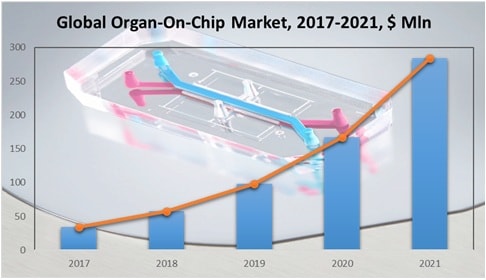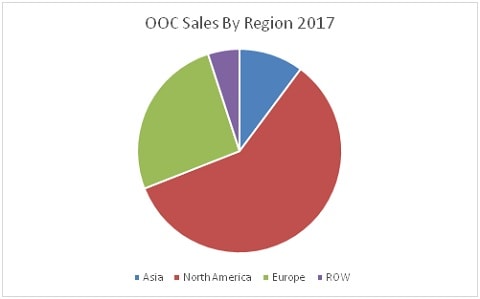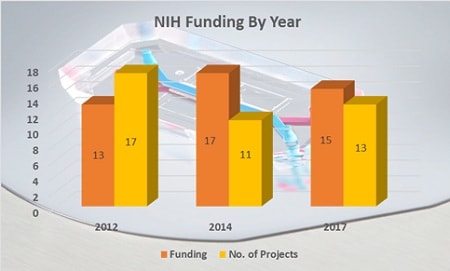The market for organs-on-chips (OOCs), the cell culture chips that imitate the activities, mechanisms and responses of organs, will be worth $284 millionby 2021, according to research from The Business Research Company in its report Organ-On-Chip (OOC) Global Market 2011-21.
The market is expected to maintain a high growth rate up to 2018, and then accelerate.

This rapid growth in such a new market will result from increases in the number of collaborative sales agreements between the pharmaceutical companies and university spin-offs and the entry of new advanced models of OOCs into the market. However, regulatory approval for drugs tested on OOCs will be needed before the potential demand is realized and complex manufacturing technology is a supply-side restraint.

North America, particularly the USA, is the largest market for organs-on-chips, followed by Europe. These are the regions where most drug development is currently undertaken. However, Asia and the rest of the world will also see significant growth in the market up to 2021.
Organs-on-chips are microfluidic 3D cell culture devices that closely mimic the key physiological functions of body organs. The chips are not designed to biomimic an entire organ, but simulate the physiology of a single functional unit of an organ system. They have resulted from scientific advances in cell biology, microfabrication and microfluidics which allow the emulation of the human micro environment in vitro. This unique feature of OOCs is made possible by integrating biology with advanced engineering technologies. Human organs-on-chips (OOCs) are miniaturized versions of lungs, livers, kidneys, heart, brain, intestines and other vital human organs embedded in a chip.
Since the organ-on-chip market is still in the research and development phase, and hasn’t been completely commercialized, it is dependent on government grants.For example, in 2012 the USA’s National Institutes of Health (NIH) established a ‘Tissue Chip for Drug Screening’ initiative. The establishment of this program was aided by NIH’s Common Fund and the National Institute of Neurological Disorders and Stroke. NIH plans to commit up to $70 million over five years for the program.
In total, 15 NIH institutes and centers are assisting in the coordination of this program. Seventeen research projects were awarded about $13 million in July 2012. In 2014, NIH began the second phase of funding for the Tissue Chip for Drug Screening Program in which 11 institutes were supported by $17 million. In September 2017, NIH funded 13 institutions. The funds allocated were close to $15 million.

The players in the OOC market are primarily university spinoffs involved in the commercialization of OOC prototypes developed in the universities. These business arms include CN-Bio Innovations, InSphero, Mimetas, TissUse, Hµrel and Nortis.
Further improvements in the design and manufacture of OOCs will probably lead to them replacing animal models as subjects in many preclinical drug evaluations in the future. According to a Senior Sales and Marketing Manager from Nortis, “The value proposition of OOCs for pharmaceutical companies is very strong in terms of reducing clinical failure rates and reliance on animal testing”.With advances in OOC technology, drug regulatory bodies have started testing OOCs for their reliability and their use as an alternative to animal testing. For instance, in April 2017, the US Federal Drug Administration announced an agreement with Emulate Inc., a US-based biotechnology company, to evaluate the company’s human organs-on-chip technology in laboratories.
OOC technology offers a less time-consuming and more cost-effective way to test for efficacy and toxicity of new drugs, foods, cosmetics and dietary supplements. Overall, they have the potential to break an impasse in in-vitro discovery and development in these fields.
Where to Learn More
Read Organ-on-Chip (OOC) Market Global Report 2011-2021 from The Business Research Company for information on the following:
Markets Covered: Organ-on-Chip, Lung-on-chip, Heart-on-chip, Liver-on-chip, Intestine-on-chip, Kidney-on-chip and Human-on-chip, Human disease and tissue models, and Microfluidics
Companies Mentioned: CN Bio Innovations, Emulate Inc., TissUse GmbH, Mimetas, HµREL Corporation (HµREL), Nortis, InSphero, Tara Biosystems, and AxoSim Techologies LLC
Regions: North America, Europe, Asia and Rest Of World(ROW)
Time series: Historic and Forecast 2011 to 2021
Data: Market volume in $ Million
Data segmentations: country and regional historic and forecast data, market share of competitors, market segments.
Sourcing and Referencing: Data and analysis throughout the report are sourced using end notes.





















